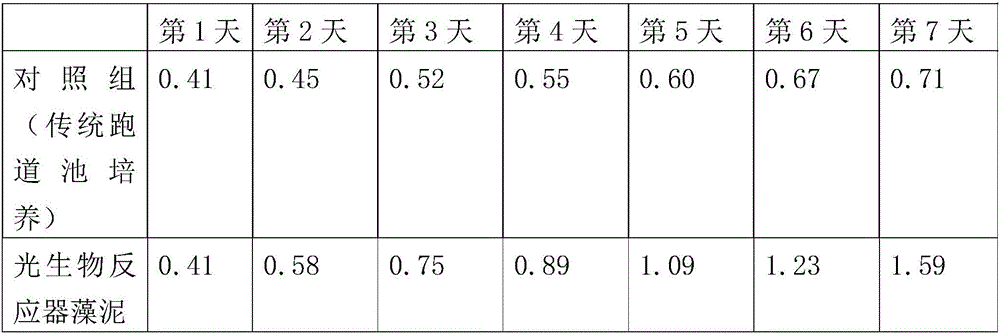Method for promoting rapid accumulation of astaxanthin in haematococcus pluvialis
A technology of Haematococcus pluvialis and astaxanthin is applied in the field of promoting the rapid accumulation of astaxanthin in Haematococcus pluvialis, which can solve the stagnation or even reversal of the accumulation process of astaxanthin, the high price of astaxanthin and the economic loss. and other issues, to achieve the effect of important economic value and operability, low price and resource saving
- Summary
- Abstract
- Description
- Claims
- Application Information
AI Technical Summary
Problems solved by technology
Method used
Image
Examples
Embodiment 1
[0023] First carry out the cultivation of Haematococcus pluvialis in the 250L runway pond, after the algal cell growth to the logarithmic phase, measure the cell concentration (OD680=0.35), the algae liquid is filtered to the microporous membrane that the aperture is 20 microns ( The filtrate is continuously cultivated in the raceway pool). If the solar radiation is not enough, artificial light can be used to induce astaxanthin; use an inducing moisturizer (pH 1.0, salicylic acid concentration 25 μg / mL) to keep the filter membrane in a wet state (relative humidity 90%). After 7-10 days, after the Haematococcus pluvialis turns red, the algae body can be collected and used as an experimental group to measure the astaxanthin content in the Haematococcus pluvialls.
[0024] At the same time, under the same breeding conditions, that is, under the condition of insufficient solar radiation, the experiment of the control group was carried out. Continue the original conditioned cultur...
Embodiment 2
[0029] It is basically the same as Example 1, except that the experimental material used is Haematococcus pluvialis cultivated in a 20L airlift photobioreactor, and astaxanthin is accumulated through the same technical method. The finally obtained data are shown in Table 2, and all data are the average value of three determinations. The results show that the Haematococcus pluvialis cultivated in the photobioreactor utilizes the method of the present invention (filtering+artificial light+spraying to induce moisturizing agent) to accumulate astaxanthin, and the highest content is 1.59%. ) were significantly different (p0.05).
[0030] Table 2: Changes of astaxanthin content (%) in Haematococcus pluvialis under different culture modes
[0031]
Embodiment 3
[0033] It is basically the same as Example 1, except that the microporous membrane used is 10 micron pore size, and the accumulation of astaxanthin is carried out through the same technical method. The final data obtained are shown in Table 3, and all data are the average value of three determinations. The results showed that the average value of astaxanthin accumulated by Haematococcus pluvialis was 1.78%, which was not significantly different from that of the filter membrane with a pore size of 20 microns (p>0.05).
[0034] Table 3 The influence of different filter conditions on the accumulation of astaxanthin in Haematococcus pluvialis (%)
[0035]
PUM
 Login to View More
Login to View More Abstract
Description
Claims
Application Information
 Login to View More
Login to View More - R&D
- Intellectual Property
- Life Sciences
- Materials
- Tech Scout
- Unparalleled Data Quality
- Higher Quality Content
- 60% Fewer Hallucinations
Browse by: Latest US Patents, China's latest patents, Technical Efficacy Thesaurus, Application Domain, Technology Topic, Popular Technical Reports.
© 2025 PatSnap. All rights reserved.Legal|Privacy policy|Modern Slavery Act Transparency Statement|Sitemap|About US| Contact US: help@patsnap.com



